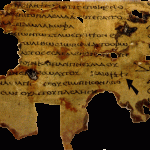
(Click to enlarge.)
Compare Matthew 9:14-17 and John 3:29-30
Jesus’ identification of himself as the “bridegroom” in these passages is an interesting one.
The relationship between God and his people is often portrayed in the Old Testament as analogous to a marriage in which God is the husband and Israel is the (often unfaithful) wife. See, for example, Jeremiah 3:1-14, Jeremiah 3:20, and Jeremiah 31:31-33. And, of course, the little prophetic book of Hosea is named after a man who, in order to illustrate the damaged relationship between the Lord and Israel, was required to take a flagrantly promiscuous woman, a prostitute named Gomer, as his wife — surely one of the most unpleasant church callings in history.
When Jesus criticizes “an evil and adulterous generation” or “a wicked and adulterous generation” that “seeks for a sign” (as in Matthew 12:39 and 16:4), that description should probably be understood in the light of the Old Testament imagery of God as husband and Israel as wife. So should the Parable of the Ten Virgins (also known as The Parable of the Wise and Foolish Virgins, Matthew 25:1-13), in which the “bridegroom” for whose coming they (and we) are to be alert is clearly Christ.
It’s noticeable, however, that Jesus calls himself “bridegroom” (νυμφίος) rather than “husband.”
Whereas, in the Old Testament, the marital relationship has already been established between God and his people, presumably via the Abrahamic or Mosaic covenant (or both), in the New Testament, it’s in the future rather than in the historic past. This is, in other words, to be a new covenant — perhaps the very “new covenant” (Hebrew בְּרִית חֲדָשָׁה [bərîṯ ḥăḏāšâ]; Greek Septuagint καινὴ διαθήκη [kainḕ diathḗkē]) that Jeremiah 31:31, already cited above, had suggested would come.
The Greek phrase that’s translated into English as “The New Testament” is, precisely, Ἡ Καινὴ Διαθήκη (“The New Covenant”), just as the Septuagint version of Jeremiah 31:31 has it.










